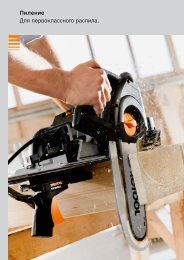Rip saw blades - CMT-SHOP
Rip saw blades - CMT-SHOP
Rip saw blades - CMT-SHOP
Create successful ePaper yourself
Turn your PDF publications into a flip-book with our unique Google optimized e-Paper software.
Saw blade safety<br />
ALWAYS thoroughly check all <strong>blades</strong> for damage and flaws before using. Do not use <strong>blades</strong> with<br />
missing or damaged teeth.<br />
ALWAYS wear safety glasses and ear protection when using power tools.<br />
ALWAYS thoroughly read the owners manual and manufacturer’s instructions before working<br />
with tools.<br />
ALWAYS use a fence and splitter when using the table <strong>saw</strong>. Do not make freehand cuts.<br />
ALWAYS use pusher blocks or a pusher stick, especially when working with small or narrow pieces.<br />
ALWAYS unplug your <strong>saw</strong> before cleaning or adjusting the tool, or before making blade changes.<br />
ALWAYS keep your tools sharpened, clean and stored in a safe place to avoid breakage and accidents<br />
and to extend the life of your bits and <strong>blades</strong>.<br />
ALWAYS feed the work against the rotation of the blade on table <strong>saw</strong>s.<br />
ALWAYS be sure your workpiece is completely supported, before and after the cut.<br />
NEVER remove guards from radial arm <strong>saw</strong>s and miter <strong>saw</strong>s.<br />
NEVER remove the splitter or anti-kickback devices from table <strong>saw</strong>s.<br />
NEVER use dull or damaged <strong>blades</strong>.<br />
NEVER use <strong>blades</strong> with missing or chipped teeth.<br />
NEVER force the cut or overload the <strong>saw</strong>.<br />
NEVER change <strong>blades</strong> with the <strong>saw</strong> plugged in.<br />
NEVER make adjustments to any <strong>saw</strong> while the blade is turning.<br />
SUGGESTED SAW BLADES ROTATION<br />
150 180 200 230 250 300 350 400 450 500<br />
SAW BLADE DIAMETER MM<br />
12.000<br />
10.000<br />
18.000<br />
16.000<br />
14.000<br />
12.000<br />
MAX RPM<br />
Cutter head safety<br />
ALWAYS<br />
ALWAYS<br />
ALWAYS<br />
ALWAYS<br />
ALWAYS<br />
ALWAYS<br />
ALWAYS<br />
ALWAYS<br />
ALWAYS<br />
ALWAYS<br />
ALWAYS<br />
ALWAYS<br />
NEVER<br />
NEVER<br />
NEVER<br />
NEVER<br />
NEVER<br />
Router bits safety<br />
ALWAYS<br />
ALWAYS<br />
ALWAYS<br />
ALWAYS<br />
ALWAYS<br />
ALWAYS<br />
ALWAYS<br />
ALWAYS<br />
ALWAYS<br />
ALWAYS<br />
NEVER<br />
NEVER<br />
NEVER<br />
thoroughly check all cutters for damage and flaws before using.<br />
SUGGESTED CUTTER HEADS ROTATION<br />
wear safety glasses and ear protection when using power tools.<br />
9.000<br />
thoroughly read the owners manual and manufacturer’s instructions before working with tools.<br />
7.900<br />
use guards that were supplied with your shaper.<br />
7.000<br />
use a fence with your shaper. Do not make freehand cuts.<br />
5.800<br />
use pusher blocks, especially when working with small or narrow pieces.<br />
5.100<br />
unplug your shaper before cleaning or adjusting the tool, or before making cutter or knife changes.<br />
78 100 120-140<br />
be sure the spindle nut is tight before plugging in the shaper.<br />
CUTTER HEAD DIAMETER MM<br />
check that knives are properly and securely installed in the cutterhead when using<br />
interchangeable-knife systems.<br />
keep your tools sharpened, clean and stored in a safe place to avoid breakage and accidents and to extend the life of your bits and <strong>blades</strong>.<br />
feed the work against the rotation of the knives.<br />
be sure your workpiece is completely supported, before and after the cut.<br />
remove guards or any other safety devices from your shaper.<br />
use dull or damaged knives.<br />
force the cut or overload the shaper.<br />
change cutters or knives or make adjustments with the shaper plugged in.<br />
make adjustments to the shaper while the cutter is turning.<br />
thoroughly check all tools for possible flaws before using.<br />
SUGGESTED ROUTER BITS ROTATION<br />
24.000<br />
wear safety glasses and ear protection.<br />
thoroughly read the owners manual and manufacturer instructions before using.<br />
20.000<br />
check that at least 75% of the shank is securely inserted into the collet of the router.<br />
18.000<br />
16.000<br />
use template guide collars when possible to absorb lateral bit deflection.<br />
use a fence when working on the router table.<br />
12.000<br />
reduce the router speed when working with larger diameter bits.<br />
25 38 50 68 89<br />
keep your fence adjusted so there is some clearance between the bearing guide<br />
ROUTER BIT DIAMETER MM<br />
and the workpiece.<br />
take care to remove large quantities of stock (cross section > 10mm) in more than one run.<br />
keep your tools sharpened, clean and stored in a safe place to avoid breakage and accidents and to extend the life of your bits and <strong>blades</strong>.<br />
use dull or defective, even suspiciously defective, tools.<br />
force the shank entirely into the collet (bottoming out). Leave about a 3,2mm (1/8”) space from the bottom.<br />
force the bit into your router or overload the router.<br />
MIN. RPM<br />
MAX RPM<br />
MAX RPM




